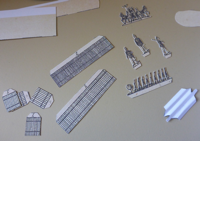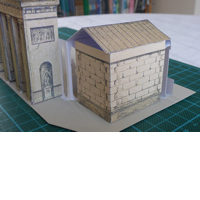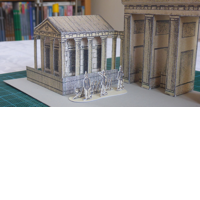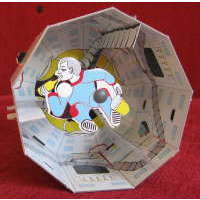
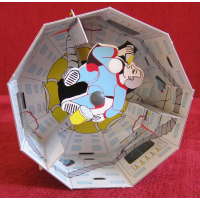
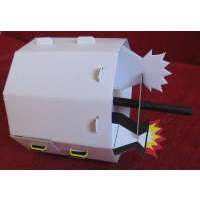
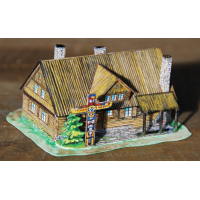
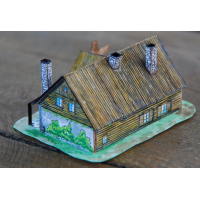
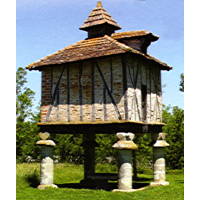
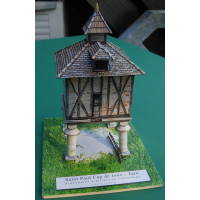
The first picture shows the original tower as it stands in Saint Paul. The model is pretty accurate, with good graphic detail, a pleasure to look at. A similar view of the model is below.
(Pigeonnier Saint Paul Cap de Joux, published by Piroux, 1:100, 7.5x9x10 cm, postcard-style model equivalent to 1 sheet A4)


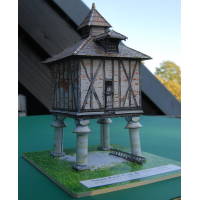
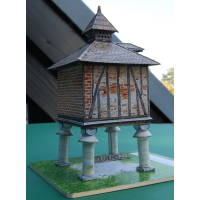
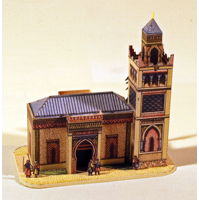
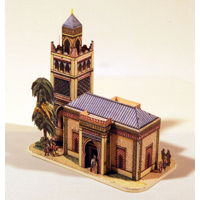
The model is a good example of the educational models that were all the rage at the time of its first print run, showing exotic settings and scenes to an interested public. It was the time of colonialism, too, and people wanted a glimpse of those far-off lands they heard a lot about. The newly-invented lithography made it possible to provide this at an affordable price, while circuses added the "live" experience.
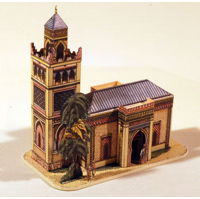
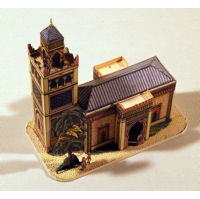

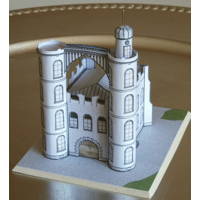
The palace was built as a pleasure palace by King Frederick Wilhelm II for his lady friend Wilhelmine Encke (later made Countess Lichtenau) and completed in 1797. Conceptually it is part of his summer castle in Potsdam, in easy reach from there and also on the road from Berlin to Potsdam, good to spend a day (or night) there at the king's convenience. Unfortunately the king died in the year the palace was completed, and Countess Lichtenau was banned.

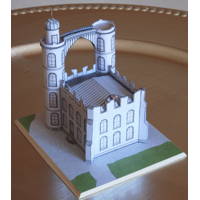
The model is very precise and was fun to build. Lots of small parts, using a lens and tweezers is highly recommended!


The Brandenburger Tor as it looked in 1850 (source: Wikipedia).
The Brandenburger Tor (or Thor, as they used to write it at the time- i. e. Brandenburg gate) has been a landmark of Berlin since 1793. Originally it had been built as a gate of the old Berlin customs wall (1734); it is the only of the 18 gates that still exists today, though the names of some other gates are still present as place names. It got its current appearance in 1793; it was named "Gate of Peace" by Friedrich Wilhelm II. who had it built, but the name did not stick. The architect was C. G. Langhans, the quadriga was designed by J. G. Schadow.
The model shows the gate in the state it had from 1868 on, when the customs wall was demolished and the storage rooms ("remises") on the north and south sides were replaced by open column halls. These halls are not present in the model, but it shows the (unrecognisable) statues of Mars and Minerva in the places they were moved to at the same time (i. e. in niches in the southern and northern walls, respectively).

The wing buildings under construction
The model sheet I used is the reproduction of a lithographic print published in 1875 by Oemigke & Riemenschneider, Neuruppin (sheet #5940). The original sheet size was 33,5x42 cm; I built the model from a copy reduced to A3 (85%) and printed on 250 g/m2 (0,25 mm) paper. The original scale is not given, but it must be something like 1:220 (i. e. approx 1:260 in my copy). The built size of my reduced model is 22,4 x 7,5 x 10 cm, which would make the original size something like 26,4 x 8,8 x 11,8 cm.
The model is pretty basic (I did not say easy to build – see below), typical for that type of one-sheet prints. It is mid-way between a model, a toy and an educational object. Regarding the latter, this gate was the one through which every victorious army in Berlin used to march in triumph. When the sheet was printed, the latest such event would have been quite recent: The parade for Prussia's victory in the war against France, 1871.
Small parts: quadriga, fences, soldiers
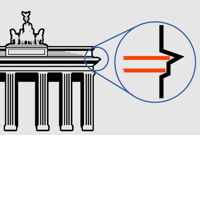
While the litho-prints of the famous Neuruppin print shops were a technological achievement, many of the model sheets (including this one) bear all the marks of a product that was made for profit, not for love of the subject: Historical inaccuracies, forgotten lines, inconsistent line types, wrong numbering, clashing glue tabs and tabs without counterpart are common. I admire the girls and boys of the time who were able to build such models based on the marginal building instructions they got (including just one stamp-sized illustration). This generation of children must have been very patient and diligent – or maybe just obedient. Let me conclude on a positive note and say that the geometric precision of the model is quite good.
I found it useful to add some internal structure to the cornice construction of the gate itself (part 1/2 and 6): I added 2 rectangles of stiff cardboard (shown in red) to the interior to ensure that it kept the intended size. Otherwise it would be possible to move the entire top of the gate like an accordion. This also made some of the less accessible tabs on parts 6 obsolete.
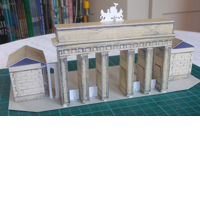
"Potëmkin" gate
The gate is oriented "inwards", its more elaborate front points towards the "Unter den Linden" boulevard (i. e. towards the city, and ultimately the "Berlin city castle"): The gate was designed to create a grand stage for the monarch when he rode into the town; the guard and customs buildings would then make "stage wings". The model boldly takes this idea up by simply omitting some construction elements that point outwards. Although there are bottom tabs, the model sheet does neither include nor mention a base plate; the bases you see here are my addition.
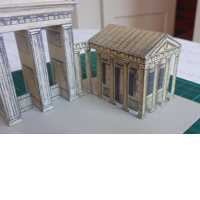
Customs building (north)
I built the model twice, once in a basic "don't-add-what's-not-there" museum version, and once trying to make the most of the model, including a nice base and some colour – but still not using any material that would not have been available in 1875.
Included in the model are some soldiers, part of the permanent gurad at the gate; the southern, fenced-in wing building is the guard room. I decided to put the 4 small fences provided with the model into the outer lanes; historical images show that at least these lanes could be closed (otherwise it would not be much of a gate). However, the location of fences and fence gates varies a lot between different images.

